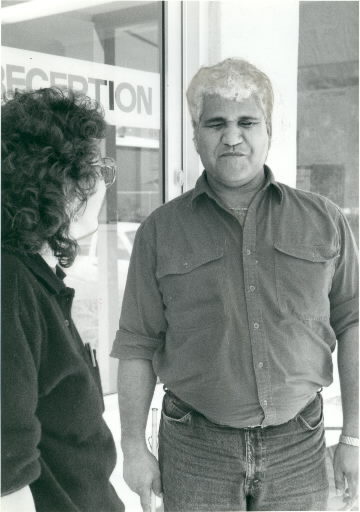3. The Fight for Compensation
Feb. 15, 2013
Chapter 3: The Central, South Pacific and Australia
Part 4: Britain’s Forgotten Legacy
Part 4: Britain’s Forgotten Legacy
"It was that black fog at the time of the test, that's what made me lose my sight." This claim by Aboriginal rights activist Yami Lester was headline news in the May 3, 1980, edition of the Advertiser, an Adelaide paper.
Although it had been twenty-eight years since the British last conducted nuclear tests in Australia, this was the first time that the issue of radiation-linked diseases suffered by Aborigines had been raised in public. Lester is at present claiming compensation from the government for the loss of his sight.
Lester witnessed the black fog on October 15, 1953. At the time he was with forty other members of his tribe outside the restricted area at Wallatinna, 110 miles northeast of the Emu Test Site in the Great Victoria Desert.
"That morning we heard this great explosion, and suddenly everyone was running round in a panic. About four or five minutes later this black fog with sand mixed in it covered the camp." Two weeks later Lester lost the use of his right eye. The vision in his left eye was also greatly impaired, and four years later he became totally blind.
"Some of my friends got sick, too. Diarrhea, nausea, sore eyes," said Lester, listing the symptoms of acute radiation sickness. "But I was only twelve at the time, so I don't really remember what happened to the others," he added.
Following the publicity given to Lester's case in the press, new evidence supporting his claims and those of other Aborigines began to come to light. White residents added their voices to the growing demands for a proper investigation; some claimed to have seen dead Aborigines in the desert, others said that they too had experienced the black fog, and yet others confirmed that people living in the areas near the site had not been warned about the tests.
Military personnel who had participated in the tests also began to seek compensation. The government found itself no longer in a position to ignore the problem, so in July 1984 a committee was established to conduct a thorough investigation into the alleged effects of the testing. A year later, the committee reported that there was a strong possibility that the Aboriginal community at Wallatinna had been exposed to radioactive fallout, and recommended that some form of compensation be given. However, the committee was not convinced that Lester's blindness had been caused by exposure to radiation. The majority of committee members believed that his condition had been brought about rather by trachoma, a severe eye inflammation caused by insanitary conditions and poor diet.
Lester visited Hiroshima and Nagasaki in August 1989, to speak about his experiences at several public meetings, and to meet with Japanese radiation victims. He described his reason for publicizing his story as follows: "I heard a scientist saying on the radio how they had done their best to ensure that no Aborigines were within range of the radiation. This made me so angry I went to the papers with my story. We've not only lost our land, but we're also suffering from radiation-linked diseases. The government is really taking its time in handing out compensation and getting round to cleaning up the contaminated area."
The Australian government has drawn up a plan of compensation for the Aborigines which is based on the general accident compensation law. The result is that the amount of compensation offered would be the same as the unemployment allowance.
Lester disagrees strongly with this policy, claiming that it is ridiculous to place exposure to radioactive fallout on the same level as unemployment. The government has recently indicated that it is nearing a final decision on the question of compensation. In all there are fifteen Aborigines making claims, and Lester is prepared to fight in court until their demands are met.








